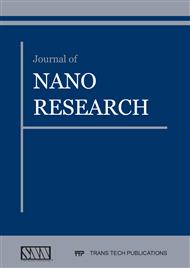[1]
Moorey, P. R. S., Ancient Mesopotamian materials and industries: The archaeological evidence, Oxford, UK: Clarendon Press, (1994).
Google Scholar
[2]
Vandiver, P. B. and Kingery, W. D., Egyptian faience: The First High-Tech Ceramic, in Ceramics and Civilization (W. D. Kingery, ed.), American Ceramic Society, Westerville, OH, (1987), p.19–34.
Google Scholar
[3]
Nicholson, P. T., Faience Technology, in UCLA Encyclopedia of Egyptology (W. Wendrich, J. Dieleman, E. Frood, and J. Baines, eds.), UCLA, Los Angeles, (2009), p.1–11.
Google Scholar
[4]
Tite, M. S., Manti, P. Shortland, A. J., A Technological Study of Ancient Faience from Egypt, Journal of Archaeological Science, 34, (2007), p.1568–1583.
DOI: 10.1016/j.jas.2006.11.010
Google Scholar
[5]
Noble, J. V., The Technique of Egyptian Faience, American Journal of Archaeology, 73, (1969), p.435–439.
Google Scholar
[6]
Vandiver, P., Appendix A: The manufacture of faience. In Ancient Egyptian faience: An analytical survey of Egyptian faience from Predynastic to Roman times, by Alexander Kaczmarczyk, and Robert Hedges, Warminster: Aris & Phillips Ltd., (1983), pp. A1 - A143.
DOI: 10.2307/631617
Google Scholar
[7]
Nicholson, P. T. and Peltenburg, E., Egyptian Faience, in Ancient Egyptian Materials and Technology (P. T. Nicholson and I. Shaw, eds.), Cambridge University Press, Cambridge, (2000), p.177–194.
DOI: 10.1163/182539100x00795
Google Scholar
[8]
Riccardelli, C., Mass, J., Thornton, J., Egyptian Faience Inlay Techniques: A process for obtaining detail and clarity by refiring, MRS Proceedings, 712, (2002), pp.545-570.
DOI: 10.1557/proc-712-ii10.7
Google Scholar
[9]
Liang, H., Sax, M., Saunders, D., Tite, M., Optical coherence tomography for the non-invasive investigation of the microstructure of ancient Egyptian faience, Journal of Archaeological Science, 39, (2012), pp.3683-3690.
DOI: 10.1016/j.jas.2012.06.007
Google Scholar
[10]
Sadek, H., SEM-EDX microstructure characterization of Ptolemaic faience beads from Egypt, International Journal of Conservation Science, Vol. 7, (2016), pp.1065-1070.
Google Scholar
[11]
Tite, M. S., Freestone, J. C., Rimson, M., Egyptian Faience: An Investigation of the Methods of Production, Archaeometry, 25, (1983), p.17–27.
DOI: 10.1111/j.1475-4754.1983.tb00658.x
Google Scholar
[12]
Moussa, A. and Ali, M. F., Color alteration of ancient Egyptian blue faience, International Journal of Architectural Heritage: Conservation, Analysis, and Restoration, 7:3, (2013), pp.261-274.
DOI: 10.1080/15583058.2011.634960
Google Scholar
[13]
Rehren, T., A review of factors affecting the composition of early Egyptian glasses and faience: alkali and alkali earth oxides, Journal of Archaeological Science, 35, (2008), pp.1345-1354.
DOI: 10.1016/j.jas.2007.09.005
Google Scholar
[14]
Helmi, F.M., and Abdel-Rehim, N.S., Study of color conversion by time in ancient Egyptian faience artifacts, Scientific Culture, Vol. 2, No 3, (2016), 17-23.
Google Scholar
[15]
Manoudis, P., Karapanagiotis, I., Tsakalof, A., Zuburtikudis, I., Panayiotou, C., Super-hydrophobic Polymer/Nanoparticle Composites for the Protection of Marble Monuments, 9th International Conference on NDT of Art, Israel. (2008).
DOI: 10.1016/j.surfcoat.2008.10.041
Google Scholar
[16]
Manoudis, P., Karapanagiotis, I., Tsakalof, A., Zuburtikudis, I., Kolinkeová, B., and Panayiotou, C., Surface properties of superhydrophobic coatings for stone protection, Journal of Nano Research, 8, (2009), 23-33.
DOI: 10.4028/www.scientific.net/jnanor.8.23
Google Scholar
[17]
Aslanidou, D., Karapanagiotis, I., and Panayiotou, C., Tuning the wetting properties of siloxane-nanoparticle coatings to induce superhydrophobicity and superoleophobicity for stone protection, Materials and Design, 108, (2016), 736-744.
DOI: 10.1016/j.matdes.2016.07.014
Google Scholar
[18]
Aslanidou, D., Karapanagiotis I., and Lampakis, D., Waterborne superhydrophobic and superoleophobic coatings for the protection of marble and sandstone, Materials, 11, (2018), 585.
DOI: 10.3390/ma11040585
Google Scholar
[19]
Manoudis, P., Tsakalof, A., Karapanagiotis, I., Zuburtikudis, I., Panayiotou, C., Fabrication of Superhydrophbic Surfaces for enhanced Stone Protection, Journal of Surface & Coatings Technology, 203, (2009), 1322-1328.
DOI: 10.1016/j.surfcoat.2008.10.041
Google Scholar
[20]
Mosquera, M. J. and De los Santos, D. M., New Water-Repellent Nanomaterial for Protecting and Consolidating Stone, 11th International Congress on Deterioration and Conservation of Stone, Torun, (2008).
Google Scholar
[21]
De Ferri, L., Lottici, P., Lorenzi, A., Montenero, A., Salvioli-Mariani, E., Study of Silica Nanoparticles – Polysiloxane Hydrophobic Treatments for Stone–based Monument Protection, Journal of Cultural Heritage, 12, (2011), 356-363.
DOI: 10.1016/j.culher.2011.02.006
Google Scholar
[22]
Kapridaki, C. and Maravelaki-Kalaitzaki, P., TiO2-SiO2-PDMS nano-composite hydrophobic Coatings with self-cleaning properties for marble protection, Progress in Organic Coatings, 76, (2012), 400-410.
DOI: 10.1016/j.porgcoat.2012.10.006
Google Scholar
[23]
Helmi, F. M, and Hefni, Y. K., Nanocomposites for the protection of granitic obelisks at Tanis, Egypt, Mediterranean Archaeology and Archaeometry, 16 (2), (2016), 87-96.
Google Scholar
[24]
Schanda, J., Colorimetry, Wiley-Interscience John Wiley & Sons Inc., (2007), p.56.
Google Scholar
[25]
Cassie, A. B. D., and Baxter, S. Wettability of porous Surfaces, Trans. Faraday, (1944), 546-551.
DOI: 10.1039/tf9444000546
Google Scholar
[26]
Tsakalof, A., Manoudis, P., Karapanagiotis, I., Chryssoulakis, I., Panayiotou, C. (2007) Assessment of synthetic polymeric coatings for the protection and preservation of stone monuments, Journal of Cultural Heritage, 8, 69-72.
DOI: 10.1016/j.culher.2006.06.007
Google Scholar
[27]
Torraca, G., Lectures on Materials Science for Architectural Conservation, The Getty Conservation Institute, U.S.A, (2009), 107-109.
Google Scholar
[28]
Baglioni, P., Giorgi, R., Dei, L., Soft condensed matter for the conservation of cultural heritage, C. R. Chimie, 12, (2009), pp.61-69.
DOI: 10.1016/j.crci.2008.05.017
Google Scholar


